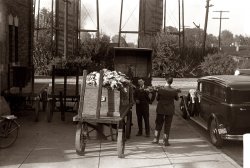
MAY CONTAIN NUTS

Search Shorpy
SHORPY ART

Framed or unframed, desk size to sofa size, printed by us in Arizona and Alabama since 2007. Explore now.
Join and Share
Ad-Free Shorpy
Shorpy is funded by you. Patreon contributors get an ad-free experience.
Learn more.

Recent comments
- If You’re Like Me, Never
- U.S.A.
- S&P
- 1940 Zenith radio model 6G601
- Quality goes in before the name goes on!
- Snazzy skirt
- Carbon Arc Lamps
- Illuminate us
- I remember it well
- I can't prove it
- Complicated then, forgotten now
- Bryan-Stevenson
- Skinny is as skinny does
- How do you rest in peace
- Riding the footboards
- Alas, hidden from view
- Baldwin Diesels
- Exclusive pump
- Bananas, Oysters and Smokey Joe
- Details, Details
- What's that building to the left of the tower?
- Coal Barges
- Bromo-Seltzer
- Inner harbor
- The Basin
- What a headache!
- Giant stepladder?
- Yeah, it was cold
- Love those coats
- Link & Pin Days Remnant
Member Photos
The Shorpy
Print Emporium
Print Emporium
Search Shorpy
Search results -- 30 results per page
- Santa Fe Elevator: 1915
- ... here.
(The Gallery, Boats & Bridges, Chicago, DPC, Railroads) ... Posted by Dave - 04/19/2016 - 10:10am -
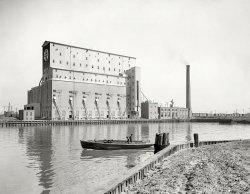
- Dwight Depot: 1900
- ... Glad it's still around to enjoy.
(The Gallery, DPC, Railroads) ... Posted by Dave - 08/20/2012 - 4:22pm -
![Dwight Depot: 1900 Circa 1900. "Chicago & Alton station at at Dwight, Illinois." Home to a very healthy looking telegraph pole. Detroit Publishing glass negative. View full size.
Now a historic Amtrak site.From Red Carpet Corridor:
Built in 1891, the depot was designed in the Richardson Romanesque style, measuring 75' x 25' surrounded by an 18' concrete platform. The foundation is Joliet stone and the building is made of Bedford bluestone from Indiana. Gables extend from each side with four double hung windows on the ground floor. The second story features two coupled windows with a fanlight over each. The facing stone above the fanlight has DWIGHT carved it in. Each gable has a quatrefoil ornament on top.
In 1983, the Dwight Historical Society bought the depot from the town. Restoration began in 1984 to transform the building into our Village Hall. When the village built a new Village Complex in 1998, the Dwight Historical Society moved the Museum into the north end of the building. The south end is a meeting room for the Historical Society and also houses the office of the Dwight Chamber of Commerce.
Architectureville, ILDwight is also home to a 1905 bank designed by Frank Lloyd Wright, the 1933 Ambler's Route 66 Texaco Gas Station, and the 1857 "Carpenter Gothic" Dwight Pioneer Gothic Church.
The polesI just looked the telephone poles. They are made of old "curvy" wood which maybe has grown somewhere in north. In addition I wonder how carefully the timber parts are finnished: A small "roof" up on each!
Merry-go-round for the birds?Odd looking weather vane!
Healthy is right! Thanks for all the recent pics with insulators. I was getting kind of jittery without them!
You have a following of insulator collectors waiting in the shadows for me to be the watchdog and tip them off when you post shots of old glass and porcelain insulators in use.
Climbing the poleI just realized (in the full size view) that poles don't have those metal "rungs" any more for climbing the pole. I guess all service work is now done from a cherry picker.
The Far SideIn 1900, Dwight was a junction. The C&A had a branch line extending to Lacon and Washington, Illinois. That must be the track in the foreground, which apparently is now gone. The main line, where most of the traffic and business would have been transacted, and which is still there, is on the far side of the building.
Next Stop: the White CityTo those of you familiar with Dr. H.H. Holmes or Erik Larson's bestseller "The Devil in the White City," Dwight was home to the famous Dr. Keeley's "gold cure" for alcoholism. It was this program that brought not only throngs of the rich-and-famous, but Holmes's assistant, Benjamin Pitezel to Dwight. While there Pitezel met Emeline Cigrand, a beautiful typist at the institute. Unable to resist, Holmes would offer Emeline twice her salary to come to Chicago to work for him.
One can almost picture the naive Emeline waiting for her train, less than a decade before this picture was taken. Like so many girls of the gilded age, she fell victim to the lure of the big city. Unfortunately for Emeline, that would not be all to which she risked falling victim...
Another ViewThis shows a birdseye of the front, sans poles.
Crazy weathervaneAnyone have any idea what the contraption is below the wind vane above the right side extension of the building?
Is it on the depot or the structure behind it?
Looks like there could be a glimpse of a grain elevator directly below it, under the roof line.
[It's electric lights atop this water tower. - Dave]
Victorian internet The telegraph cables slipped through the window connected Dwight to the world wide web of the Victorian era.
Little tiny depotNow there is a building just destined to be constructed as part of someone's model railroad layout!
Here it is todayFrom a different angle.
SubtleHow the roof pitch changes from the shallow pitch over the open areas to the steeper pitch over the building proper. Very nicely done. Glad it's still around to enjoy.
(The Gallery, DPC, Railroads)](https://www.shorpy.com/files/images/4a20229a.thumbnail.jpg)
- Railroad Crossing: 1906
- ... breeze.
(The Gallery, Boats & Bridges, DPC, Memphis, Railroads) ... Posted by Dave - 10/01/2013 - 10:50am -
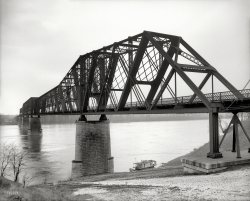
- Tall Grain: 1939
- ...
(The Gallery, Agriculture, Arthur Rothstein, Railroads) ... Posted by Dave - 03/05/2018 - 11:13am -
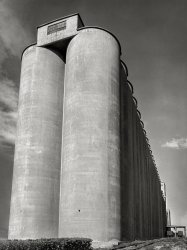
- Sic Transit: 1910
- ... the (sadly, now gone) station.
(The Gallery, DPC, NYC, Railroads, Streetcars) ... Posted by Dave - 11/08/2019 - 10:44am -
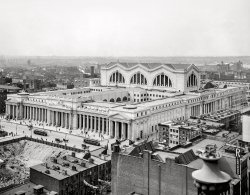
- Working on the Railroad: 1899
- ... View full size.
(ShorpyBlog, Member Gallery, Railroads) ... Posted by Kyle Bagnall - 08/31/2010 - 10:28am -
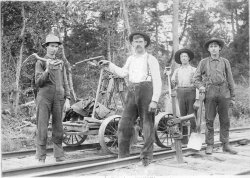
- Tucked In: 1905
- ... every weekend.
(The Gallery, Boats & Bridges, DPC, Railroads, Streetcars) ... Posted by Dave - 08/08/2012 - 7:11pm -
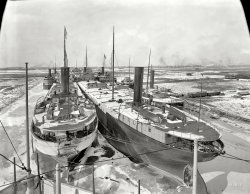
- Midnight Special: 1957
- ... If this isn't a movie set it oughta be.
Fantastic!
(Railroads, Rural America, Small Towns) ... Posted by Dave - 10/28/2013 - 9:37am -
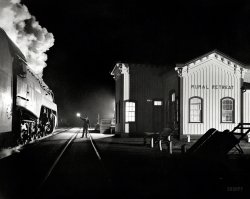
- Over and Under: 1900
- ... Very racer looking.
(The Gallery, Bicycles, DPC, Kids, Railroads) ... Posted by Dave - 08/13/2013 - 3:44pm -
![Over and Under: 1900 Circa 1900. "Grade separation near Arlington, New Jersey." 8x10 inch dry plate glass negative, Detroit Publishing Company. View full size.
Transit SuperiorityTruly the two most romantic forms of travel man has ever created.
Classic 4-4-0That's about the most beautiful locomotive I've ever seen! They must have been burning special coal to have no visible smoke coming from the stack (bet it helped keep it clean too). By 1900, though, that classic layout was already considered obsolete.
You could probably see your reflection in the polished connecting rods and valve linkage.
Does anyone know what railroad this is? I can see lettering on the passenger car but can't quite read it even in HR. It isn't "PRR" (Pennsylvania, the one I remember from my NJ childhood).
[This is the Delaware, Lackawanna & Western locomotive seen earlier here. - Dave]
Two great looking wheelsand the cleanest steam locomotive on earth.
Howard Boulevard and Route 80I remember this from when I was a kid in the sixties. That's right by the back entrance to the Hercules powder plant. Today there is a park-and-ride.
Dressed to the ninesBoth the dapper looking youngsters and that gorgeous engine! The engine, quaint even by the standards of 1900, would look like it's going 100 MPH sitting still!
The GeneralA picture of the boys and their bikes would be interesting enough but this is an amazing picture. There's obviously something more interesting to look at than the camera or the train. The locomotive itself reminds me of Buster Keaton's "The General."
Road of AnthraciteThis is indeed the Delaware, Lackawanna and Western RR. The Lackawanna promoted its clean passenger service using "Hard coal, no cinders" with a creation of the ad guys known as Phoebe Snow.
A pretty lady was hired to be Miss Snow, and the campaign ran for many years before the Great War. A modern diesel powered streamliner placed in service after WWII was named "The Phoebe Snow" in honor of the original.
All of the fuss was about the DL&W burning lump anthracite, which didn't create cinders as soft coal did. The little American-type locomotive above has a long, narrow firebox [under the back end of the boiler and forward of the cab] which identifies the 128 as a lump burner.
These engines ran commuter trains from all over northern New Jersey to the Hoboken ferries at the turn of the last century. They had brief careers, however. They were replaced by larger engines that were demoted from mainline service by about 1910.
Hi-def look at the coach reveals a small "M&E" on the left end of the letterboard. This refers to the Morris and Essex Division. The coach also is lettered below the windows possibly indicating some sort of photographer's car.
[The car was the "Detroit Photographic Co. Special," which we'll be seeing more of, and whose progenitors carried DPC partner William Henry Jackson through Mexico and the American West in the 1880s and 1890s when he was exposing his "mammoth plates" -- 18x22 inch glass negatives taken by giant view cameras that were the Imax equivalent of the era, so massive they required a locomotive to haul around and develop. - Dave]
DPC SpecialThis special train was used by the Detroit Photographic Company to haul its photographers, equipment, and darkroom all over the country. The locomotives varied but the passenger car was specially fitted just for the company and as Dave noted, was owned by the Lackawanna. From what I understand, the DPC made at least two railroad excursion trips - one in 1899 and a second in 1902. Clearly they made other trips to gather photos that spanned several decades but the photo trains may have been more limited.
In quite a few other DPC photos you can see a locomotive pulling a single DPC passenger car somewhere in the distance. Before good roads and automobiles, the train was pretty much the only way to get anywhere that was more than a few miles away.
The photo below from the collection shows William Henry jackson sitting inside the DPC car.
Slick and sleekIt looks like this loco has been 'hot rodded'. Very slick indeed.
In three years that cycle on the left looks like it might have a Harley-Davidson motor slung into its frame.
Wonderful image, once again.
Dickson 4-4-0 Standard?
Railway and locomotive engineering, Vol. 8, 1895.
Equipment Notes
The Delaware, Lackawanna & Western have ordered two eight-wheel passenger engines from the Dickson Locomotive Works. They have received bids for 500 coal cars, and expect to award the contract this month. The road is very short of coal cars.
The pictured locomotive could be one of DL&W's Dickson Locomotive Works 4-4-0 Standard engines. Related photos on the web: here and here. The Lackawanna also owned several Dickson 4-4-0 Camelbacks but this photo is clearly not a camelback.
Straight skinny on the DL&W 128I had to go through my books and look this up.
The 19th century DL&W had the peculiar practice of having separate number series for each division.
Thus, our 128 was built by Dickson in 1876 with shop number 183, as DL&W Morris and Essex Div. no. 100 [During this period, she was named, logically enough, "Centennial"]. She weighed 87000 lbs in working order, and was renumbered in the general renumbering [1899, I think] to DL&W no.128. She was scrapped in 1909.
Detroit Photographic CarThe car may have changed depending on the railroad. The Denver Public Library has quite a collection of Detroit Photographic images as well, including these showing the car and a locomotive on the Chicago and North Western railroad.
http://digital.denverlibrary.org/u?/p15330coll21,8799
http://digital.denverlibrary.org/u?/p15330coll21,8796
The car is clearly a C&NW car.
Upgrading a bikeI noticed that the older boy has upscaled his bike to cool by flipping the handlebars over. Very racer looking.
(The Gallery, Bicycles, DPC, Kids, Railroads)](https://www.shorpy.com/files/images/4a07234a.thumbnail.jpg)
- Extra Firm: 1905
- ... me last Friday.
(The Gallery, Boats & Bridges, DPC, Railroads) ... Posted by Dave - 07/08/2014 - 1:09pm -
![Extra Firm: 1905 Circa 1905, location not specified. "Please go 'way and let me sleep." 8x10 inch dry plate glass negative, Detroit Publishing Company. View full size.
He must have drifted off quicklyA fetal tuck would have been a better position on that pier. He will wake up with sore kneecaps.
Don't laugh; this could be youI've seen railroaders curl up and doze in some pretty incredible situations. (I never was much good at that.) But that was in the modern era.
A typical work schedule for any "blue collar" employee (not "worker", a Bolshevik term) in the early 20th century was 10 or 12 hours Monday-Friday, and half day on Saturday. They gave you Sundays off and the two holidays were Christmas and July 4 with holiday pay optional. Also, in 1905 mechanical aids in work were just starting to show up on some jobs. Muscles were cheaper than machines.
This fellow worked a lot harder than most of us could do today. Spend a day with our friend here, and you could crash right along side of him.
A look at the shadow indicates midday, and no one is around but the "suit." This guy's sleeping through lunch break.
Barlow Boye Co.If we could locate the Barlow Boyle Co. (see sign on the building behind the bridge, we might have a location).
Nothing came up on Google or Ancestry.
[The sign says Barron Boyle -- a maker of paints and varnishes in Cincinnati. - Dave]
Thanks Dave, for the correction. Now I see it. I was also thinking "Barton," but your eyes are sharper. A. S. Boyle established a paint and glass company first located on West Court Street and then 428 Main Street. The advertising sign, however, may have been on any building in Cincinnati.
TrendsetterHe's the first to demonstrate the "Lying Down Game" where 105 years later people amuse themselves by assuming a stiff horizontal position in random places and then post it for everyone else's amusement.
http://www.lyingdowngame.net/
His Sleep Numberis B50.
Cat napI appreciate Old Buck's view of what is going on here. When I first looked at it, I thought this was a homeless man, and very sad, but it makes more sense that he would be a "blue collar" employee just taking a cat nap before going back to work. My grandfather, who was a sugar-beet farmer, would always lie down for twenty minutes, after dinner (the noon meal). Thankfully, Grandpa had a comfortable couch to lie down on, though!
His Sleep Number ...is B50. Notice the wooden stob protruding from the piling. Did they not use metal rebar back then?
C&O Railroad BridgeThis is the C&O Railroad Bridge in Cincinnati at the very northernmost end. The picture would be looking east, or upriver. If the picture were broader to the right you would be able to see the Roebling Suspension Bridge about a quarter mile upstream. The C&O Bridge was built in the late 1880's.
40 winks?That'll B50.
A little rest.My father worked for Con Edison in Brooklyn. When they worked on a site a tool trailer was dropped off, the workers reported direct, Dad got to wherever he had to be that day by trolley, bus and/or train.
One day after lunch he told his partner that he was going to close his eyes for ten minutes, and to wake him up at 12:30. He sat down with his back against a utility pole.
About 2:30, he woke up to find his partner laid out fast to sleep on the little grass strip between sidewalk and street.
They had some catching up to do, but didn't get caught.
AmazingThe poor fella must be totally exhausted. And the shoes? Maybe the pair at the foot of his bed would fit him. They seem to be in better condition. Great picture, Dave. Thanks.
BustedThat was me last Friday.
(The Gallery, Boats & Bridges, DPC, Railroads)](https://www.shorpy.com/files/images/4a17949a.thumbnail.jpg)
- Farmville: 1940
- ... very scenic.
(The Gallery, Agriculture, John Vachon, Railroads, Rural America, Small Towns) ... Posted by Dave - 12/30/2019 - 8:25pm -
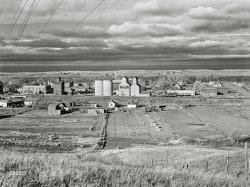
- Magic Kingdom: 1905
- ... a single image.
(The Gallery, Boats & Bridges, DPC, Railroads) ... Posted by Dave - 08/15/2012 - 4:14pm -
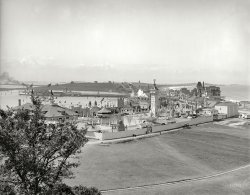
- Oops: 1905
- ... sites.
(The Gallery, Boats & Bridges, Chicago, DPC, Railroads) ... Posted by Dave - 08/21/2012 - 10:50am -
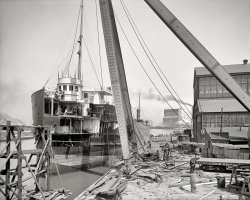
- Fox River Mills: 1899
- ... go into details.
(The Gallery, Boats & Bridges, DPC, Railroads) ... Posted by Dave - 04/26/2018 - 6:19pm -
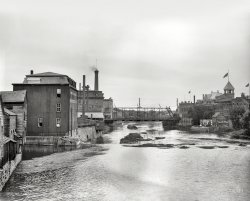
- Eleventh Avenue Flagman: 1911
- ... he tries a razor the first time!!
(G.G. Bain, Horses, Railroads) ... Posted by Dave - 12/10/2007 - 6:01pm -
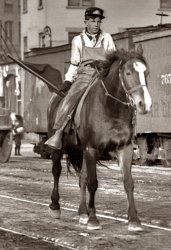
- DPC Special: 1902
- ... in 1940 or early 1941. - Dave]
(The Gallery, DPC, Railroads, W.H. Jackson) ... Posted by Dave - 04/03/2018 - 8:02am -
![DPC Special: 1902 In this car, known as the California Special, I toured the Southwest in 1902 with a display of pictures for the Detroit Publishing Company.
-- William Henry Jackson, "Time Exposure"
"Detroit Photographic Co. Special." William Henry Jackson seated in a Delaware, Lackawanna & Western Railroad car. I've been reading WHJ's autobiography, "Time Exposure," which he began in his tenth decade and completed in 1940, two years before his death at age 99. Highly recommended by Shorpy's Book Club. 8x10 inch dry plate glass negative. View full size.
Cluttered but revealingThis is a marvelous image containing his best images on the walls and ceiling, his 8 x 10 camera on the desk with him, a sturdy tripod that looks light to carry, and my favorite, blotter books on the far side of his bed, weighted down to keep them flat with his pillows.
Blotter books were, as you can see, a method of drying prints and keeping them flat. Practically though, because that method takes days and days to dry the prints and the blotter paper, I always removed them after several hours and placed them on a very large framed screen that was on pulleys so it could be hoisted up to the ceiling, out of the way. The framed screen was covered with an identical screen so the prints would dry flat .
Good times!
Must be the clean living of 1902If my math is correct, he would be 59 years old in this photo. I will be 59 next month, and Mr. Jackson looks a lot younger than I do!
[WHJ was indeed noted for his youthful appearance in midlife. - Dave]
Good genesAnd not just longevity-wise. That has to be the youngest-looking 59-year-old guy I've ever seen. Take away the mustache and I'd say he was maybe 25. Maybe it was exposure to all that photo fixer early on.
[This may have been taken in the Eighties or Nineties and published in 1902. (Where's that background wall calendar when you need it?) Here's WHJ circa 1904. Below, the old man in his 90s. - Dave]
At 97 and countingThere is a wonderful article from Time Magazine, dated April 15, 1940, on a exhibit of Jackson's work.
Last week the museum on the first floor of Secretary Harold Ickes' new, white, boxlike Department of the Interior Building in Washington was given over to an exhibition of Pioneer Jackson's aged photographs. Admired by public and connoisseurs alike were the vivid detail and panoramic scope of the mountain and forest views that Old Master Jackson had snapped with his battered, wooden 6½-by-8½ camera in days when photography was scarcely more than a stunt. Best exhibit of all was spry Oldster Jackson himself, stooped and white-bearded but talkative and effervescent at 97.
William Henry Jackson still takes pictures, but with an up-to-date Leica, does a little sketching on the side, spends his spare time polishing his autobiography, which is due next month. Says he: "A fellow has to keep busy or he gets bored. I'm never bored." Three years ago, when his cronies of the G. A. R. hobbled bravely down Manhattan's Fifth Avenue in their Memorial-Day parade, Veteran Jackson failed to march. "Poor old Bill!" sighed his aged brothers-in-arms. Later they discovered that Bill Jackson had been dodging in & out of the crowds all along the route, taking pictures of the parade.
Last StopThere's also a nice writeup of him and a photo of his tombstone at Find-a-Grave that's worth a visit.
Bravo.Luz, espacio 3D, detalle, escenografía, encuadre: Todo. Bravo por WHJ.
Gracias.
"A private railroad car is not an acquired taste...""One takes to it right away." So said Eleanor Robson Belmont.
I imagine this holds true if the company is paying for it, and even if half of the car is taken up by darkroom and storage. And no, I don't think he looks 59. I look young for 43, and he looks a bit younger than me. Maybe he's like the Queen. Or Deepak Chopra.
Color me curious black and whiteI'm hoping someone will have the answers to two questions. 1. What is that box-like device hanging from a strap near the lamp next to Mr. Jackson? 2. Easier - what was the purpose of the saucer shaped tops about a foot over each of the wall lamp glass chimneys? Probably to catch soot, but how?
Maxfield ParrishJust add a few nymphs posing here and there among the rocks and trees and those photographs are amazingly similar to the beautiful Maxfield Parrish prints of the day!
So Time Travel IS Possible!Apparently Geraldo Rivera has gotten his hands on a time machine. You can just see the wheels turning in his brain as he works on his next expose.
Think About Running WaterLooking at the (exquisite) photos on display in Mr. Jackson's rail car, I just have to ask, did he have bladder problems?
Soot catcherDutch asked: ... what was the purpose of the saucer shaped tops about a foot over each of the wall lamp glass chimneys? Probably to catch soot, but how? Soot is in the hot vapor that rises straight up from the flame. All the catcher has to do is just be there close above it. Without those, the soot would coat everything immediately above the lamp, plus also tend to disperse in the air and gradually get all over everything else in the room.
Wm. H. Jackson and Henry FordHere's another view of Wm. H. Jackson. I bought this image at an antiques store a couple of weeks ago. If my math is correct, it's from 1942. A faint "Associated Press Photo" stamp is on the back, so I'm not sure if you can use this. But I thought you'd be interested in seeing the great man from another angle.
[Most fascinating! If WHJ was 97 when this picture was made, it was taken in 1940 or early 1941. - Dave]
(The Gallery, DPC, Railroads, W.H. Jackson)](https://www.shorpy.com/files/images/4a20188a.thumbnail.jpg)
- Elevator Annex: 1941
- ... ever seen.
(The Gallery, Agriculture, John Vachon, Railroads) ... Posted by Dave - 04/20/2020 - 10:27am -
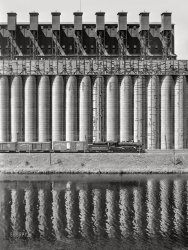
- Smoke Monster: 1905
- ...
(The Gallery, Boats & Bridges, Detroit Photos, DPC, Railroads) ... Posted by Dave - 01/22/2013 - 11:21am -
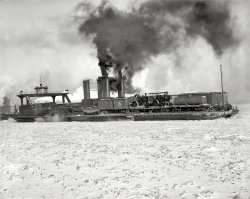
- Irrigon Oregon: 1939
- ... of her.
(The Gallery, Dorothea Lange, Landscapes, Railroads) ... Posted by Dave - 04/18/2018 - 3:53pm -
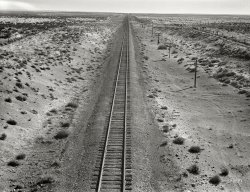
- Snow Belt Special: 1943
- ... 1950s and maybe later.
(The Gallery, Jack Delano, Railroads) ... Posted by Dave - 03/17/2015 - 9:39am -
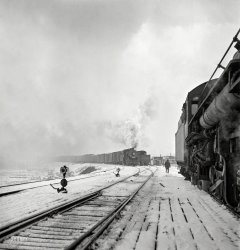
- Our Excellent Adventure: 1942
- ... of Camels been tucked?
(The Gallery, John Collier, Railroads) ... Posted by Dave - 03/12/2014 - 11:07am -
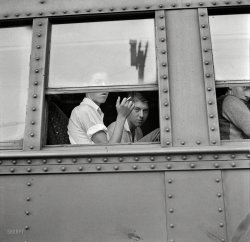
- Work, From Home: 1941
- ... Power Station.
(The Gallery, Factories, John Vachon, Railroads) ... Posted by Dave - 02/19/2020 - 4:17pm -
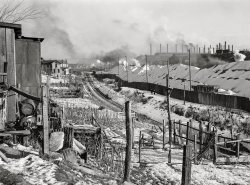
- West of Fargo: 1939
- ... apart.
(The Gallery, Arthur Rothstein, Landscapes, Railroads) ... Posted by Dave - 08/27/2018 - 9:10pm -
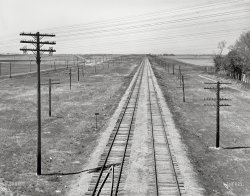
- Magical Minot: 1941
- ... them. Still have a couple.
(The Gallery, M.P. Wolcott, Railroads) ... Posted by Dave - 10/12/2019 - 1:31pm -
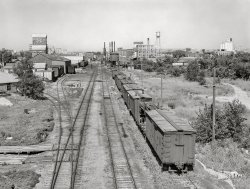
- Old King Coal: 1925
- ... - Dave]
(The Gallery, D.C., Natl Photo, Railroads) ... Posted by Dave - 09/12/2011 - 2:29pm -
![Old King Coal: 1925 Another view from 1925 of the W.H. Hessick & Son coal yard in Northeast Washington, D.C. By December 1925, the company had moved to 14th and Water Streets S.W. National Photo Company Collection glass negative. View full size.
W.H. Hessick coal yardDave, I think these photos of are of the Hessick Coal yard at 14th and Water streets S.W. Three reasons:
If these photos were of of facilities at 53-59 N sreet N.E., why would the sign have to include the information regarding the location of the office?
Consulting the 1919-1921 Baist Realty Maps, the orientation of the pictured sidings corresponds very well with a coal yard at 14th and Water streets S.W. (shown below). The maps of the area at 53-59 N sreet N.E, while close to the B&O tracks, shows no coal yard or similar sidings. In addition to the general track layouts, two additional details seem to fit with this location: The Bradley School was located at 13 ½ & D streets S.W. and could be the building visible in the background (under the gantry crane) of the earlier photo; The signal bridge shown in this photo is consistent with a location over the main tracks of the Philadelphia, Baltimore and Washington Railroad
.
A 1924 advertisement (also shown below) displays a line of trucks in front of what appears to be the facilities at 53-59 N St N.E. It is not the clearest image but the buildings and signage appear quite different from these photos.
(click on images for larger versions)
[The company's advertising prior to December 1925 has the coal yards on N Street N.E. The map below, from 1919, shows numerous coal yards and sidings there. The yard would have the address sign because it's east of the main office. Click to expand. - Dave]
(The Gallery, D.C., Natl Photo, Railroads)](https://www.shorpy.com/files/images/31760u_0.thumbnail.jpg)
- Locomotive Makeover: 1942
- ... had any 4-8-4s.
(The Gallery, Chicago, Jack Delano, Railroads) ... Posted by Dave - 04/26/2013 - 2:11pm -
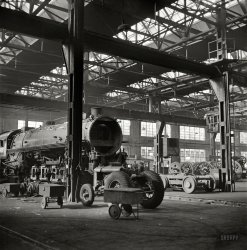
- Brave New World: 1925
- ... of the photo.
(The Gallery, Cars, Trucks, Buses, Railroads) ... Posted by Dave - 11/01/2015 - 1:14pm -
![Brave New World: 1925 A lantern slide of Frances Bode's photograph titled "Repetition," from the 2nd International Salon of Pictorial Photography (1925), New York. View full size.
Wherever ya lookWherever you look, you see "it" again. I wonder if he saw that aspect after he took the image, or if he took the picture because he saw it. I like it a lot.
[Frances Sophia Margaret Bode (1892-1974) was a she. - Dave]
Mea culpa. I sincerely hope the kind lady will forgive me.
IntricateThat is some seriously intricate trackwork.
Just Wow!As an amateur gandy dancer that has stacked a switch for the local streetcar museum, I'm floored by this work!
car ID suggestionsL-R: Flint Six, Baby Overland, Willys Knight, unknown, small Buick, unknown, Ford, large Chevrolet, Ford, Oldsmobile, Unclear behind tree.
Yankee Stadium and Polo GroundsThat looks to be the recently built (1923) Yankee Stadium in the distance, with the Polo Grounds in the foreground to the right.
Old 159th St Yard in Manhattan?Is that the side of the Polo Grounds on the right and the original Yankee Stadium across the Harlem River in the background?
A Bridge Too Far"The two bridges in the photo both cross the Harlem River. The bridge to the right is the Macombs Dam Bridge, which still stands today. The bridge to the left no longer stands today."
Lagniappe,
I think Macombs Dam Bridge is the bridge on the left (not the right), and as you said, it is still standing.
Rare ViewThis is a wonderful photo which I’ve never seen before. It is a picture of the 159th Street train yard just north of the 155th Street station of the 9th avenue el – the northern terminus of that line. The large structure along the right side of the photo’s frame is the Polo Grounds. In the distance to the east is Yankee Stadium in the Bronx. The two bridges in the photo both cross the Harlem River. The bridge to the right is the Macombs Dam Bridge, which still stands today. The bridge to the left no longer stands today. It was used by the “Polo Grounds Shuttle.” A line that went from the 155th Street Station to the Bronx where it terminated at the 167th Street station of the IRT Jerome Avenue line.
The Giants played their last season in the Polo Grounds in 1957. Subsequently, the line saw very little patronage and it ceased operation at 11:59pm on August 31st, 1958.
It is worth noting that the Polo Grounds Shuttle line ran right through the heart of the area currently occupied by the new Yankee Stadium.
ViewThe view in this Shorpy photo was captured by standing on top of Coogan's bluff. The area today is filled with housing apartment buildings, the bridge today is gone, it was known as the Putnam bridge, and it carried subway trains from the Polo Grounds to the Sedgwick Avenue Station in the Bronx. McCombs Dam Bridge can be seen in the far right corner of the photo.
(The Gallery, Cars, Trucks, Buses, Railroads)](https://www.shorpy.com/files/images/SHORPY-03149u.thumbnail.jpg)
- Class A: 1909
- ... removed.
(The Gallery, A.P. Godber, New Zealand, Railroads) ... Posted by Dave - 06/01/2014 - 11:10am -
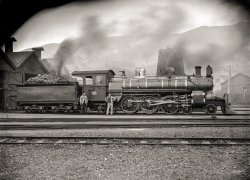
- Pennsylvania 5401
- ... long afterwards.
(The Gallery, D.C., Harris + Ewing, Railroads) ... Posted by Dave - 04/04/2013 - 3:30am -
![Pennsylvania 5401 July 14, 1929. "New Boston train, 'The Senator,' at Washington's Union Station, departing at 12:30 p.m. The train is to arrive in Boston at 10 p.m., cutting 3½ hours off the time made by the other two Pennsylvania line trains there, the Federal and Colonial expresses." Harris & Ewing glass negative. View full size.
1927 K-4?What a great pic! Is this one of those 1927 K-4's? Help us out PRR friends! Thanks for posting!
Train Christening
Washington Post, July 14, 1929.
New Boston Train to Be Christened
Ten-year-old Ellen Page Eaton will break a bottle of Potomac River water on the locomotive of a new Pennsylvania Railroad train this morning at 11 o'clock in the Union Station and christen it “The Senator.” The train will give the fastest service between Washington and Boston.
After christening, the train will be open to inspection until its time of departure, 12:30 p.m. The train is scheduled to arrive in Boston at 10 p.m., cutting 3½ hours off the time previously made by the other two Pennsylvania line trains to Boston, The Federal and the Colonial expresses.
“The Senator” will be an all-Pullman train with dining, observation and club cars. It will make stops at New York City, New Haven and Providence.
Little Miss Eaton, who will christen the train, is the daughter of John Eaton, crack engineer of the railroad, who is veteran of 28 years. …
Even Faster NowOn Amtrak's Acela Express the trip can be made in 6 hours and 40 minutes.
What's ItOK, what the thingie hanging from the train: an anchor line?
[My guess: part of the bottle-breaking ritual mentioned in Washington Post story. - tterrace]
[It's the bottle holder. - Dave]
Little Miss Eaton...must be the one in the white frilly dress.
PRR 5401A really great photo, notice the PRR emblem on the steam valve cover above the piston.
Lock box?What is the locked box on the front of the engine for?
It's a K-4built in 1927, 92 were built, Baldwin built all locomotives from 5400 to 5474, all other K-4s were built by PRR in the Juanita Juniata shops.
K-4 or K-4s?The "s" suffix in the PRR steam locomotive classification scheme denotes the presence of a superheater. PRR supposedly stopped using the "s" suffix in 1923, as by this time, the superheater was a standard design element. Nonetheless, you commonly see these locomotives referred to as K-4s. The 5401 was indeed built in 1927. Here she is a few years later looking a bit grimier:
Fresh Out of the BoxHere are an engineer and fireman whose garments will never again appear so pristine. In the glorious days of steam, anything forward of the baggage car was filthy work indeed, and even the most assiduous washing resulted merely in progressively more faded coveralls, with coal, smoke, and cinder stains intact.
Re: Lock Box and the K-4Guessing the lock box on the pilot beam contains tools and parts for quick maintenance on the road, stuff like extra lenses for the marker lamps, air and steam heat hose connections, etc, as well as the green and white flags mounted high on the locomotive which would indicate the train is running as a second section or an extra movement. At first I thought it might hold red (emergency stop) flags, fusees, and explosive "torpedoes", which are clipped to a rail and go bang when something runs over them, signaling the engineer for an emergency stop. These items, being needed by the crew quickly in an emergency, would be kept in the cab, as they still are today.
K-4 Pacifics would run on the Pennsy until 1957, but by 1935 the rails between DC and New York were electrified with overhead wires, and steam became a rarity on the line now known as the Northeast Corridor.
Automatic Train ControlThe locked box on the pilot beam is an instrument case for the Union Switch & Signal automatic train control equipment.
Train control?PRR Washington to New York had cab signals in the 1930s. The line has some form of train control now, but probably not in 1929.
Looks like PRR began installing train control (that is, automatic brake application if the engineer ignores a restrictive signal) in 1951. (Railway Age, 12 March 1951 p93 -- it's online at hathitrust.org.)
Cab Signals and Automatic Train ContolThe ICC mandated the introduction of ATC in 1922. PRR's first installation was in 1923 and they made the decision at that time to integrate cab signals with ATC. Harrisburg to Baltimore was equipped for ATC and cab signalling by 1927, and it was extended to Washington not long afterwards.
(The Gallery, D.C., Harris + Ewing, Railroads)](https://www.shorpy.com/files/images/SHORPY_35483a.thumbnail.jpg)
- Shelbyville: 1938
- ...
(The Gallery, Cars, Trucks, Buses, John Vachon, Railroads) ... Posted by Dave - 09/08/2011 - 12:57pm -
